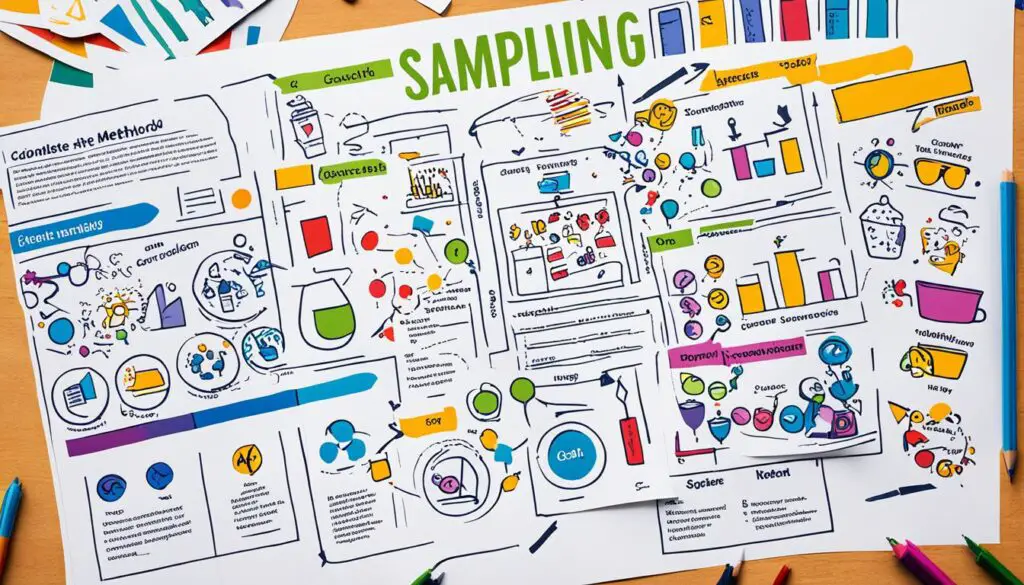Choosing the Right Sampling Methods for Your Research
Accuracy and relevancy are key in research. Picking the right sampling methods is vital. It ensures that the data you gather is fair and true. Knowing the various methods and their effects is important for researchers.
Researchers can’t study the whole population. So, they pick a group to study. This group must represent the whole population equally. A list called the sampling frame helps in this selection process.
Methods like random, systematic, stratified, and cluster are available. With random sampling, every member in the list has a chance to be chosen. Systematic sampling picks every nth person after starting randomly. Stratified sampling makes sure different groups are fairly represented. Cluster sampling chooses whole groups. Each has its pros and cons, suitable for different research needs.
Choosing the right method is a big decision. It’s crucial to know what your research aims to achieve. Understanding your population and its structure helps. Look at the study design, topic importance, and sample variability. This ensures your method will answer your question and help draw broad conclusions from your findings.
Key Takeaways:
- Choosing the right sampling method is crucial for accuracy and relevance in research.
- Sampling methods involve selecting a subset of the population for study.
- Random sampling, systematic sampling, stratified sampling, and cluster sampling are different types of sampling methods.
- Consider research objectives, population characteristics, and available resources when choosing a sampling method.
- The selected sampling method should answer the research question effectively and allow for generalizability of the results.

Introduction to Sampling Methods
Welcome to the exciting realm of sampling methods! When we do research, it’s rarely possible to study every single person or item in a group. This is because it takes too much time and resources. That’s where sampling methods become vital. They help us pick a small, but fitting, group from the bigger population to study more closely.
Understanding the basics of sampling is crucial before we explore the many methods. The first thing to know is the population. This is the whole bunch of people or things we aim to study. It might be a bunch of people in one age group, folks living in a certain place, or potential buyers of a new product.
“Sampling methods enable us to study a subset of the population, which then helps us make inferences about the entire group, saving time and resources.”
Then, there’s the sampling frame. It’s like having a list of every person or item in the population. This list is very important. It helps make sure we can pick fairly from the entire population to be in our sample.
Getting a sample that truly matches the main population is the aim. A great sample looks a lot like the big group it came from. This way, we can trust our findings to be true about the whole population.
There are many ways to pick a sample. Researchers use various methods to select the right people or things from the list. They could use simple random sampling, or more complicated ways like stratified or cluster sampling. Each method has its pros and cons. Choosing one depends on what the research is about, what’s available, and who or what is being studied.
Alright, now we’ve got the basics of sampling down. Let’s get into some practical examples to see how all this works. Get ready for an interesting look at sampling methods!

Examples of Different Sampling Methods
In research, there are many sampling methods to pick from. Each has good and bad points. What you choose depends on what you’re studying and what’s available. Let’s look at some sampling methods:
Random Sampling
Random sampling is a popular method. It means choosing participants from a list of the whole group by chance. This helps make sure each person has the same chance to be in the sample. Simple random sampling picks people with no specific reason, just by luck.
Systematic Sampling
Systematic sampling is different. It also picks people from a list but not by chance. Here, you pick a random start and then choose every nth person. This way, it keeps things straightforward but still fair.
Stratified Sampling
Stratified sampling is good when groups in the whole population stand out. These groups are picked based on certain traits or interests. Then, people are chosen randomly from each group. This method makes sure every group is represented well in the study.
Cluster Sampling
Cluster sampling breaks the population into areas or groups. The study picks whole clusters instead of single people. This saves time and money. But, it can lead to more differences within the study groups.
“By understanding the different sampling methods and their applications, researchers can make informed decisions that align with their research objectives and resources.”
Each sampling method is good for something but also has its downsides. The method you should use depends on what question you’re trying to answer and what you have to work with. It’s crucial to think it through to get results that are valid and reliable.
| Sampling Method | Advantages | Disadvantages |
|---|---|---|
| Random Sampling | Ensures equal chance of selection, | May not capture specific characteristics of the population |
| Systematic Sampling | Simple and systematic process, | Potential for periodicity, may introduce bias |
| Stratified Sampling | Ensures representation of different strata, | Requires prior knowledge of population characteristics |
| Cluster Sampling | Saves time and resources, | Potential for variability within clusters |
Choosing the Best Sampling Method
When doing research, picking the right sampling method is key to get good results. Researchers need to look at many factors to make sure their study is fair and precise.
Research objectives: It’s crucial to have clear goals for your research. This helps in deciding the group you want to study. Knowing your research questions helps to focus and pick a fitting sampling method.
Sampling frame availability: Having a list of the people you want to study is very useful. Sometimes this list is ready, like in databases or organizations. But, if you have to make this list, it will take time and effort.
Study design: How your study is set up guides your sampling method choice. Things like how common your topic is and how much people vary play a big part. If there’s a lot of diversity, using a stratified method can help.
Random sampling: Random sampling is great for reducing bias and making your findings apply more widely. By randomly picking people from your population, you make sure everyone has an equal chance to be part of the study.
To see how sampling methods differ, let’s look at a study on car customer happiness:
Imagine I want to know how happy car owners in the U.S. are. I aim to identify what makes them really happy and what the car industry can work on.
Since there are so many car owners with different kinds of cars, a stratified approach makes sense. This method helps me cover a wide range of people in the study sample.
First, I group people based on where they live, the kind of car they own, and how long they’ve had it. Then, I pick people from each group randomly. This ensures we hear from everyone in a fair way.
This method lets me get insights from all U.S. car owners. It also lets me compare different groups in the car industry. Using random sampling within each group keeps my study fair and useful.
To select the best sampling method, think about your research goals, if a sampling frame is there, study setup, and why random sampling is beneficial. This way, you can ensure your study is on the right path for accurate and relevant results.
Note: The table below provides a comparison of different sampling methods and their key characteristics:
| Sampling Method | Definition | Advantages | Disadvantages |
|---|---|---|---|
| Random Sampling | Selecting participants randomly from a sampling frame. | – Provides a representative sample | – Time-consuming and costly |
| Stratified Sampling | Selecting participants based on specific subgroups (strata) within the population. | – Ensures representation of diverse groups – Allows for comparisons between subgroups |
– Requires knowledge of population characteristics to create appropriate strata |
| Systematic Sampling | Selecting participants at regular intervals after a random starting point. | – Simple and easy to implement | – Could introduce bias if a pattern is present in the sampling frame |
| Cluster Sampling | Selecting entire groups/clusters as the sample. | – More feasible for large populations | – Potential for increased sampling error |

Conclusion
Sampling methods are key in research, making sure our results represent the whole. Methods like simple random sampling and stratified sampling use randomness to choose people. This way, we cut bias and make our findings more trustworthy.
But sometimes, we can’t use those methods because of time or money. In those cases, we turn to things like convenience and purposive sampling. Even though these ways have their downsides, they still offer good information if we use them right.
Researchers need to pick their sampling method wisely, based on what they’re studying and who they’re studying. Matching the method to these factors helps make the results spot on.
To get findings that stand for the whole, picking the best sampling method is crucial in research. It doesn’t matter if it’s about randomness or fitting the situation; what’s important is to meet your research’s unique needs. This ensures your work is sound and accurate.
